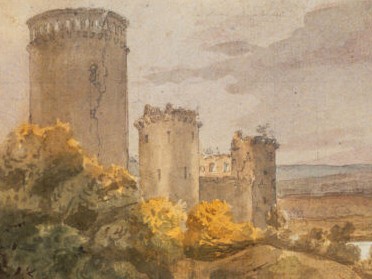Welcome to Part III of my report on A Distant Mirror, The Calamitous 14th Century by Barbara Tuchman. Read Part I and Part II to get yourselves oriented.
On Saturday, in my second of a series of posts on the book A Distant Mirror, I listed the disasters of the 1300s. Those included what Tuchman calls “the most lethal catastrophe in recorded history” — the plague known as the Black Death, which by some estimates wiped out a third of the European population between 1348 and 1350. There were also a series of English-French conflicts lasting 116 years and known as the Hundred Years’ War; a schism in the Catholic Church that resulted in two simultaneous popes; Crusades; Jew-killing; hysterical mass movements including self-flagellants and dancing maniacs; and the climate change labeled the Little Ice Age.

A somewhat huggable version of “Black Death” is among the Giant Plush Microbes available at ThinkGeek.com.
The 14th century was a time of extremes and the politically astute French nobleman Enguerrand de Coucy VII lived through many of them between 1340 and 1397.A Tuchman chose to use Coucy’s life story as a narrative thread throughout her book because not only was Coucy well-connected — inheriting a powerful barony and marrying the King of England’s eldest daughter — but he was fairly well-documented, having patronized an important chronicler of those times, Jean Froissart.
By age 10, Coucy had lost his parents to two of the scourges of his time: first, his father died at war, then his mother and stepfather fell to the Black Death. The lands he inherited in Picardy included a castle with a central tower, or donjon, that Tuchman describes as:
“… the largest in Europe, the mightiest of its kind ever built in the Middle Ages or thereafter. Ninety feet in diameter, 180 feet high, capable of housing a thousand men in a siege, it dwarfed and protected the castle at its base, the clustered roofs of the town, the bell tower of the church and the thirty turrets of the massive wall enclosing the whole complex on the hill.”
The medieval mega-structure survived relatively intact until 1917, when the German army occupying Picardy used 28 tons of explosives to blow the castle to bits. When MrB and I visited Paris last summer, we took a side trip to see those bits. We stayed in a beautiful inn whose owners were politely baffled by why we’d want to visit a bunch of ruins when there was a perfectly nice and completely restored castle at nearby Pierrefonds. This has happened to me before. In England in 2008, while I was trying to get to the ruins of Kenilworth, a cab driver said, “But there’s a real castle at Warwick, love!” I LIKE RUINS, OKAY? I get to use my imagination with ruins.

MrB where the donjon used to be.
Since we were staying at the inn and didn’t have to rush back to Paris, we went to Pierrefonds too …

The turrets at the rebuilt Pierrefonds look a little Disney to me.
… mostly so I could complain that I didn’t enjoy it as much as the Coucy castle.

The majestic ruins of Coucy.
Coucy’s castle wasn’t just big — it was high-tech. Great acoustics made it possible to holla at more than 1,000 soldiers at once, while Tuchman says one contemporary called the kitchens “worthy of Nero.” The rainwater fish pond on the roof sounds totally Soho House. And you can tell a lot about a place from its bathroom, so I was impressed by the description of the donjon‘s multi-level latrines.

Reading about latrines in the non-latrine part of the ruins of Coucy castle.
Tuchman says the underground pits used for latrine drainage were “later mistaken by investigators of a more romantic period for secret passages and oubliettes. Under the concept of ‘noble’ architecture, the 15th and later centuries preferred to ignore human elimination. Coucy probably had better sanitation than Versailles.”
The Coucy family’s ego was apparently as big as its donjon. Tuchman describes their motto as one of “simple arrogance.”
Roi ne suis,/Ne prince ne duc ne comte aussi;/Je suis le sire de Coucy.
(Not king nor prince,/Duke nor count am I;/I am the lord of Coucy.)
In layman’s terms that means: “Take that, royal people! Our donjon is bigger than your donjon.” By the way, if the word donjon rings a bell, it’s probably because the word “dungeon” comes from it.
Next Thursday: the fourth and final installment of my Distant Mirror book club posts.

omg! I loved this post! 🙂 I really liked the pics that went along with it. I have read so many books and have been to the places (castles in England) in the books and it becomes so real-such fun! Can’t wait for the next edition! :)gina
Love the post – I also prefer ruins. We saw the rebuilt in the Victorian era Cardiff Castle and I was all ‘eh, where’s the old stuff?’
To paraphrase Beavis and Butthead – old stuff is cool. heh heh heh.
love the bottom pic!!! love your blazer!
I’m really enjoying your book club posts, especially about this period. And I prefer ruins as well. I think it’s more authentic than the fancy restored castles.
I love that you bring the book with you (I do that too). Also love that you’re wearing some sort of high heeled mules to tromp around ancient sites. When I have more time (2025?) I plan on reading that book!
I love reading books about places I’m going to visit. Makes the experiences so much better. Love the photo of you in all the ruins.
i spent all morning looking at those plush microbes.
Love that you brought the book to the castle. Was there a moat? I wish I had a moat surrounding my apartment…
I just happened upon your blog and I love it…have been reading through all your posts and I think they are truly gorgeous…will be back!
Love love love,
Erin
xx
Fabulously written post, darling!
Love the pics too!
Have a wonderful weekend 🙂
xoxox,
CC
THhese posts are great! They’re making me want to delve back into medieval fashion, my original academic focus.
Great post! I’m aching to take a dreamy, nerdy trip to Europe again.
For now, I live vicariously through your book club.
(Not sure if this is a repeat as I had an error when I tried to post). Your baffling locals by wanting to see the ruins is fantastic. Ruins are to books as Castles are to movies.
And I LOVE your stone age loo.
Great post Wendy! Ruins are always great.
My kids love those microbe plush toys.
the turrets do look like the disney castle!
Very nice post. Beautiful pictures as well. The turrets really do look like the Disney castles I’ve seen. Thanks for the share and keep it up.
Love that you post on such varied topics.
http://stylenuggets.blogspot.com
omg. the plush microbes! and your mules (to walk the ruins) are killing me. love.
xxx
t
i’ve never seen jersey shore. maybe i should watch it to get some style ideas. haha.
thanks for your comment! as a child I was fascinated with castles, so this was really interesting to read.
Your capacity for storing and rattling off interesting information just amazes me.
You are a great story teller Wendy!
I loved the images and is it wrong that I want that more huggable version of black death?
Happy easter honey
xxx
marian
One of my fave posts of yours. You look so cute reading the book 😛
Latrine drainage can be romantic. For some people.
I live very close to castle ruins, the Priory castle in Tynemouth which sits on a cliff that overlooks the North Sea. The structure began as an Anglian monastery in the 7th century and was rebuilt after the Danes raided it in 1090. You can still see how it was a great fortress (though not great enough it seems) and how parts of the coastline were built to ward off intruders coming by sea.
isn’t it the other way around and Disney did the borrowing? No time for Paris..dommage 🙁
I love ruins, too. I’ve seen some great ones on Cyprus. But castles blow my mind!
Finally a castle with plumbing and someone blows it up. Yeesh!